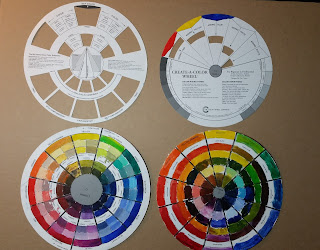Grammar of Color by Miss Helen Dryden for Vogue from www.munsell.com
Interesting example of a reference to color harmony for Vogue in 1921: http://munsell.com/color-blog/grammar-of-color-helen-dryden-vogue-proofs/ Part 12 is given here, but at the bottom of this article there are links to previous parts of A Grammar of Color. This example describes an interesting take on color harmony based on an assumption that all the colors in a plate should become a neutral gray when mixed (rather than a mud brown, for example). The use of a circle with the proportion of the colors used is also interesting. Also copied here: A Grammar of Color – Part 12: Two Proofs of a Design by Miss Helen Dryden for Vogue We have been posting excerpts from the 1921 book, “ A Grammar of Color ”, by T.M. Cleland with an introduction by Albert Munsell . The first half of the book focused on explaining how the Munsell Color System works, and suggested ways it can be used. We now start the second half of the book, which consists of some color illustration examples fo




